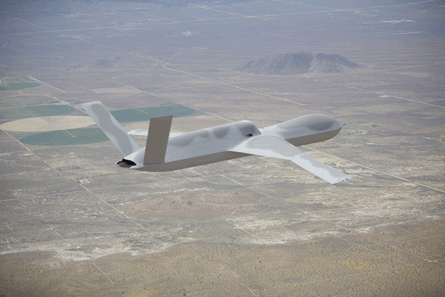The head of General Atomics Aeronautical Systems has defended the company's strategy on the Predator C Avenger for the MQ-X follow-on contract even as US Air Force requirements appear to be shifting to a larger airframe.
General Atomics unveiled the Avenger four months ago as a jet-powered and stealthy follow-on to the USAF's growing fleet of MQ-1 Predators and MQ-9 Reaper unmanned aircraft systems.
However, the USAF's new UAS flight plan, released in late July, says acquisition delays have started blending requirements for the MQ-X with a potentially larger series of aircraft. Beyond MQ-X, the USAF outlined a vision for a modular family of increasingly more capable vehicles called the MQ-M.
 |
|---|
© General Atomics Aeronautical Systems |
"If their requirements are real they wanted a bigger airplane [for the MQ-M series] going up around 20,000lb [9,071kg]," says General Atomics chief executive Tom Cassidy.
That aircraft size exceeds the maximum gross weight of the Predator C by about one-third. "The Predator C will go up to about 15,000lb," Cassidy says. The first Predator C flying prototype weighed about 5,220kg at first flight, he adds.
Gross weight for the second Predator C, which is scheduled to fly in the fourth quarter next year, will increase to about 6,080kg, which includes adding more fuel in the fuselage and 910kg of fuel in the weapons bay, he says.
By investing in the Predator C before the USAF finalised its requirements, General Atomics took a familiar gamble. As the USAF decided to buy Predator As and Predator Bs off the shelf, the company gave it a chance to avert the risks of a conventional acquisition process.
"I looked at what they're talking about for the [MQ-X], and the Predator C pretty much meets all those requirements," Cassidy says. "Now these requirements continuously change. Predator C is what it is. It's so long, so wide, so heavy, and it's got a jet engine, an internal weapons bay. We designed it for what we thought they wanted next."
Separately, Cassidy also says his engineers are evaluating several electronic warfare payloads for the Predator C. The studies are focused primarily on wide area airborne surveillance (WAAS) sensors. Sierra Nevada is developing the Gorgon Stare payload, which has a camera that can track multiple targets at the same time. But the company is also considering other WAAS sensors, says Cassidy, adding "whatever else the air force comes up with".
Source: Flight International























